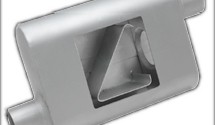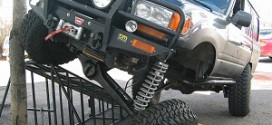 Several years ago, I wrote an article detailing the installation of a hydroboost unit (picture of my first conversion on the right) from an early ’80s Cadillac into my 1969 Bronco. In that article I gave information on how hydroboost works and shared details on the installation process and my initial impressions after the unit had been installed.
Several years ago, I wrote an article detailing the installation of a hydroboost unit (picture of my first conversion on the right) from an early ’80s Cadillac into my 1969 Bronco. In that article I gave information on how hydroboost works and shared details on the installation process and my initial impressions after the unit had been installed.
Never one to leave well enough alone, I’ve made a few  changes to my system that are worth sharing for those people who may be interested in performing such a conversion themselves. The information I have learned in the intervening two years since I first installed my system could make the difference between disappointment and elation with how well your brakes work after installing hydroboost in your own Bronco.
changes to my system that are worth sharing for those people who may be interested in performing such a conversion themselves. The information I have learned in the intervening two years since I first installed my system could make the difference between disappointment and elation with how well your brakes work after installing hydroboost in your own Bronco.
In my initial article, I stated how pleased I was with the performance of the booster with the exception of the “squishy” brake pedal. After bleeding the system numerous times, the pedal feel stayed the same and I concluded that this feel was a characteristic of this booster. Conversations with several others familiar with the system confirmed my beliefs.
In late 2002, I purchased a late model Ford Super Duty pickup as my daily driver. This truck, equipped with a diesel engine, uses a hydroboost system due to the lack of vacuum generated by the diesel. The pedal feel in the Super Duty was different than the Bronco’s. It had much less pedal travel, felt more progressive, and had a firm pedal.
Around this same time, I began conversing with a gentleman named Paul Clark, who owns a firm in Michigan called Hydratech Braking Systems. Hydratech’s core competency is engineering kits to install late-model hydroboost setups into cars originally equipped with vacuum boosted or manual braking systems. After several conversations with Paul, I knew I should work on retrofitting a newer booster to the Bronco.
A hydroboost unit from a wrecked Super Duty was soon located at a local junkyard. As with the earlier unit, the main engineering challenges in retrofitting such a unit to the Bronco involved several key interfaces:
-
Booster pushrod-to-brake pedal interface
-
Booster-to-firewall interface
-
Booster-to engine clearance
-
Booster-to-master cylinder interface.
Once again, the long-suffering gentlemen at Protofab fabricated a bracket or two for me that allowed the booster to mate to the firewall at a 90° angle. The bracket was designed to give enough clearance between the booster and the upper SEFI intake on my engine. The booster was shipped off to Hydratech for modifications to the pushrod to allow it to mate up to the Bronco brake pedal assembly.
When the booster was returned, I flipped it 180° from its OEM mounting position so the nitrogen-charged accumulator did not interfere with the intake manifold on the engine. This also meant the lines to the booster would now enter from the bottom, which lends a cleaner look to the unit. The hydroboost units attach to their mounting brackets via an oddly shaped nut with four flats on it. I had my machinist, Lynn Wiebe of We-Be Machining, fashion a nut tool from a modified 4×4 hub tool.
The final interface was to mount my Chrysler master cylinder (re-used from the previous system) to the booster. I bored out the holes in the Chrysler master cylinder and also shortened the booster pushrod to mate up to the master cylinder piston.
 After shortening the existing pressure lines, re-bending some brake lines, and bleeding the system, it was time for some road testing to see how the system performed. Initial impressions were positive. The system seemed to be less touchy, the pedal was firmer, and remarkably, the front/rear brake balance was better. With the earlier hydroboost unit, I had problems with premature rear brake lockup that even an adjustable proportioning valve couldn’t cure. This led to some scary moments in panic stopping situations and was particularly unnerving in off-road situations when the rear brakes would lock up and skid long before the fronts would even think of ceasing rotation. With the Super Duty unit, my braking is balanced well enough as-is that I could remove the proportioning valve if I so desired.
After shortening the existing pressure lines, re-bending some brake lines, and bleeding the system, it was time for some road testing to see how the system performed. Initial impressions were positive. The system seemed to be less touchy, the pedal was firmer, and remarkably, the front/rear brake balance was better. With the earlier hydroboost unit, I had problems with premature rear brake lockup that even an adjustable proportioning valve couldn’t cure. This led to some scary moments in panic stopping situations and was particularly unnerving in off-road situations when the rear brakes would lock up and skid long before the fronts would even think of ceasing rotation. With the Super Duty unit, my braking is balanced well enough as-is that I could remove the proportioning valve if I so desired. Based on the results of another system recently installed on another friend’s Bronco, the next step in the development of my configuration will be to replace the 1.125″ bore master cylinder with a 1.25″ bore unit. Due to the pressures developed by these units, larger bore master cylinders are not a problem. In fact hydroboost units love big bore master cylinders. My friend’s brake pedal has a little less free travel than mine without any perceived sacrifices in stopping power.
The evolution of this brake boosting system has reached a point where it can conclusively be stated that this is the finest configuration I have ever assembled in my truck. The combination of pedal effort, pedal travel, stopping power, brake balance, and visual appearance are extremely pleasing to this extremely fussy Bronco owner!
The development and retrofitting of the Super Duty booster unit into my truck has led to the introduction of hydroboost brake booster kits for Early Broncos, manufactured by Hydratech Braking Systems, and sold through several Bronco vendors.
Technical Sources
Firewall Plate Fabrication & Welding ProtoFab, Inc. 20295 Conestoga Dr.
Cordes Lakes-Mayer, AZ 86333.
Phone: 520-632-0216
Website: www.protofab4x4.comMachining, Threading, etc.
We-Be Machining 4520 W. Bryce Lane.
Glendale, AZ 85301
Phone: 602-284-7456.Hydroboost Braking Components
Hydratech Braking Systems 26642 Haverhill
Warren, MI 48091
Email: info@hydroboost.com
Website: www.hydroboost.com
 4x4Review Off Road Magazine
4x4Review Off Road Magazine


